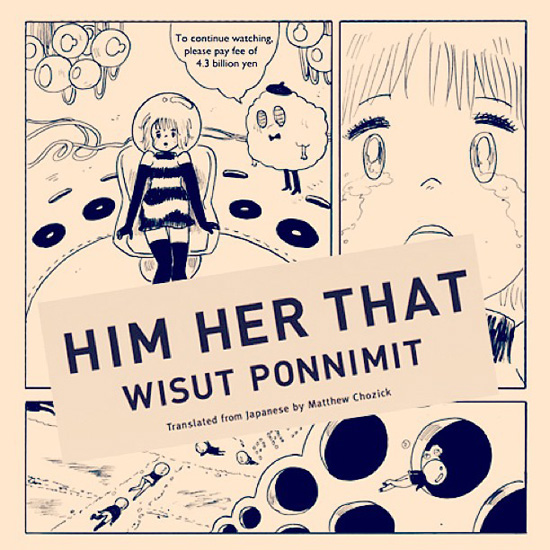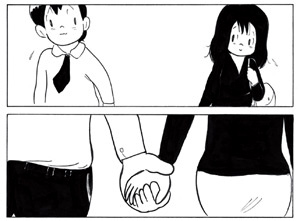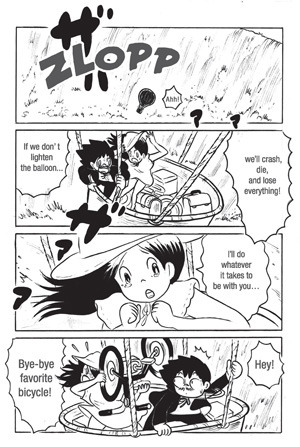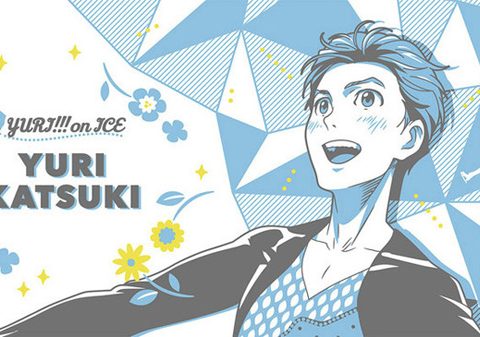
Picture this: A couple, madly in love, is flying aboard a hot air balloon. They’re in trouble: the load must be lightened or the balloon will crash into a ravine.
“Maybe I should jump,” says the man. “You’d have a good life.”
“No!” screams the woman, “I’ll jump too! Let’s die here together! That’s true love, isn’t it?
Finally, the solution: they decide to jettison their heavy ideas about what “love” is. Free from the weight of their own expectations, they fly free.
Clever metaphors and musings on love, romance, the relationships between men and women permeate Him Her That, a new collection of manga out this month. If it doesn’t sound like your typical manga fare, perhaps that’s because they come from a pretty atypical artist: Wisut Ponnimit.
Hailing from Thailand, Ponnimit moved to Japan about ten years ago and quickly made an impression with his quirky, deceptively simple artwork and offbeat yet touching tales.
He’s somewhat of a cult sensation in Japan: a winner of the Japan Media Arts Award for outstanding manga, his characters adorn designer T-shirts, his art is shown in galleries in Shibuya, and he’s worked with literary legends like Banana Yoshimoto. Oh, and he makes his own anime, too.
But the west hasn’t had a chance to get to know Ponnimit’s work – until now. Awai Books, an independent Tokyo- and New York-based publisher, has released a collection of Ponnimit’s work called Him Her That in paperback and on Kindle.
Fans of alternative, independent manga ought to give Him Her That a look. It’s a pretty charming collection of stories that hit touch that bittersweet, nostalgic, tangy part of the heart.

Below, a short chat with Ponnimit:
OUSA: What does the title (Him Her That) mean?
Ponnimit: The stories are about men and women and the things between them.
OUSA: There are very few non-Japanese people working in the manga industry. Did you face any special challenges breaking in?
Ponnimit: I have never tried to make 100% Japanese manga look-alikes, so it wasn’t difficult to me. I just do what I can do and I won’t do what I can’t.
OUSA: You mentioned in a previous interview some of your inspirations are Mitsuru Adachi (Touch) and Osamu Tezuka... is there anyone working now you admire?
Ponnimit: I also like Rumiko Takahashi’s work, especially her art from the 80’s. Honestly, I’ve fallen out of touch with a lot of the new manga coming out recently.
OUSA: What is the comics scene like in Thailand at the moment? Is there anyone doing what you’re doing?

Ponnimit: Yes, there’s a new generation of manga artists who have come after me. Their works are inspired by the style of life in Thailand. In the 90’s Thai artists had a more Japanese-like aesthetic.
OUSA: I heard you decided the art should be flipped in the U.S. version. Why did you decide on that?
Ponnimit: In Thailand people read left to right, so most Japanese manga books in translation are also flipped for us. In the flipped books there are sometimes wonderful errors like backwards numbers on soccer jerseys. I spot these kinds of mistakes and love them. Despite occasional errors I enjoy reading imported works in a natural way.
I also read original manga in Japanese and I like its right to left formatting. While I do prefer to read Japanese texts in this way, with Thai translations I enjoy my country’s formatting and find it easier to follow. I think many readers have a similar preference and I want the reading experience to seem natural to them.
OUSA: You’ve worked with huge stars like Banana Yoshimoto. Is there anyone else out there you dream about collaborating with?
Ponnimit: I think I’d be happy to collaborate with anyone. I’ve met many stars and have found they are all equally human like everyone. Because of this, it could also be said that everyone is a star. The world is filled with great people living great lives.



![Kaguya-Sama: Love Is War Volume 1 [Review] Kaguya-Sama: Love Is War Volume 1 [Review]](https://otakuusamagazine.com/wp-content/uploads/2018/03/169-loveiswar2-480x360.jpg)
![Dreamin’ Sun [Manga Review] Dreamin’ Sun [Manga Review]](https://otakuusamagazine.com/wp-content/uploads/2017/09/DREAMIN_SUN_1-interiors-48-480x360.jpg)

![[Review] My Youth Romantic Comedy Is Wrong, As I Expected [Review] My Youth Romantic Comedy Is Wrong, As I Expected](https://otakuusamagazine.com/wp-content/uploads/2017/08/hp-yaharilovecom_v1-0051-480x338.jpg)
![Hard to Find Much to Love About New Film Zutto Mae Kara Suki Deshita [Review] Hard to Find Much to Love About New Film Zutto Mae Kara Suki Deshita [Review]](https://otakuusamagazine.com/wp-content/uploads/2017/08/zuttoreview-480x338.jpg)